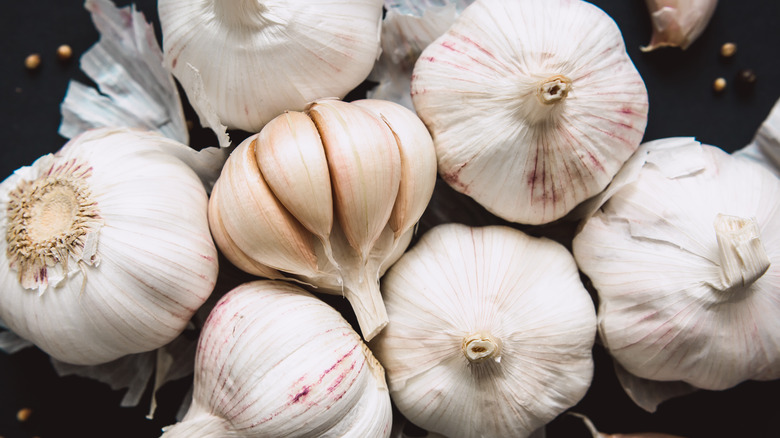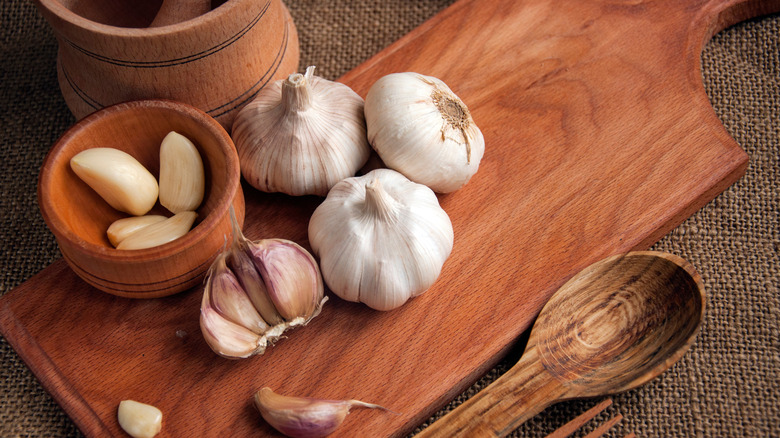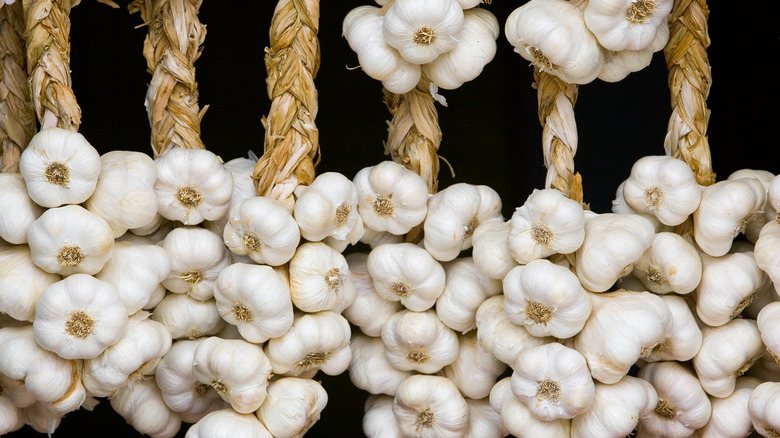The Reason Garlic Was Called 'Russian Penicillin' In WWII
Acrid when raw and mellow when sautéed, roasted, or confit, the ubiquitous garlic is one of the most immediately recognizable flavors, as well as an incredibly healthful ingredient. It pops up in a seemingly endless array of recipes and preparations, lending its iconic, palatable flavor to a slew of dishes. Rarely it is celebrated on its own volition, though; it often plays a supporting role, except for in dishes like a roasted chicken with multiple heads of garlic, garlic confit oil, or the ol' standby, garlic bread. Beyond its delicious flavor profile, though, do you know just how healthy garlic really is?
This quote from an article in the Pharmacognosy Review (posted at the National Library of Medicine) sums it all up: "at the time when antibiotics and other pharmacy products did not exist, a bulb of garlic itself represented a whole pharmacy industry due to the broad spectrum of effects." In addition, "garlic extracts have been found to have antibacterial and anti-fungal properties," according to The Linus Pauling Institute at Oregon State University's Micronutrient Information Center. There are also nutritional advantages: "At only 4 calories per clove, garlic is packed with manganese, vitamins B1, B6, and C, selenium, fiber, calcium, potassium, iron, and more," as noted by Health Company, which also states that garlic is beneficial to help lower high cholesterol, blood pressure, and also strengthen the immune system.
How did the name 'Russian penicillin' originate?
As reported by the Los Angeles Times, garlic's noteworthy healthy benefits were noticed "as early as 1500 B.C.," when Egyptians used garlic as a means to alleviate conditions such as cardiac issues, general weaknesses, headaches, and migraines. During World War II, garlic was actually referred to as "Russian penicillin" for its amazing healing properties — it was used to treat wounds and injuries incurred on the battlefield.
Where did that name come from, you may ask? Western New York Urology Associates explains that "garlic was called Russian penicillin during World War II because, after running out of antibiotics, the Russian government turned to this ancient treatment for its soldiers." It is said that garlic "poultices" were utilized in order to ward off infection of open sores or wounds. In addition, in 1961, the British government "issued a general plea for the public to supply it with garlic in order to meet wartime needs," and that Louis Pasteur's original experimentation involved using garlic as a means of killing bacteria. Furthermore, Urology Associates notes that "there is no question that raw garlic can kill a wide variety of microorganisms by direct contact, including fungi, bacteria, viruses, and protozoa." Clearly, garlic is an especially powerful ingredient, belied by the cloves' diminutive size.
The historical health uses of garlic
Garlic also contains something called allicin, which boasts antibiotic properties, and when crushed, chopped, or cut, garlic releases allicin, which is also the cause of that super-fragrant, deeply garlicky aroma and which contains some of garlic's most healthful components.
The American Society for Microbiology (ASM) notes that garlic has been used within traditional Chinese medicine primarily for "respiratory and digestive issues," while indigenous North Americans used garlic to mitigate "flu-like symptoms." ASM notes that allicin can alleviate symptoms associated with the flu, herpes, rhinovirus, cytomegalovirus, and reduce the amount of parasites in the body. ASM notes that all alliums contain allicin and alliinaise, but garlic boasts a much higher amount of it than leeks, onions, or chives.
Karin Edgett notes that it is important to cut, slice, chop, or crush garlic and let it sit for a good 10 minutes prior to using it in any capacity, which will concentrate the allicin even more, activating and elevating its healthy properties. Of course, garlic can also be eaten raw, but it's not nearly as palatable, and can be overtly strong and almost burning. Bon Appétit reported in 2014 that Dr. Albert Schweitzer used garlic to treat dysentery. As ASM writes, perhaps the old adage should actually be changed to "a (crushed) clove of garlic a day keeps the doctor away" instead. (No offense, apples.)


